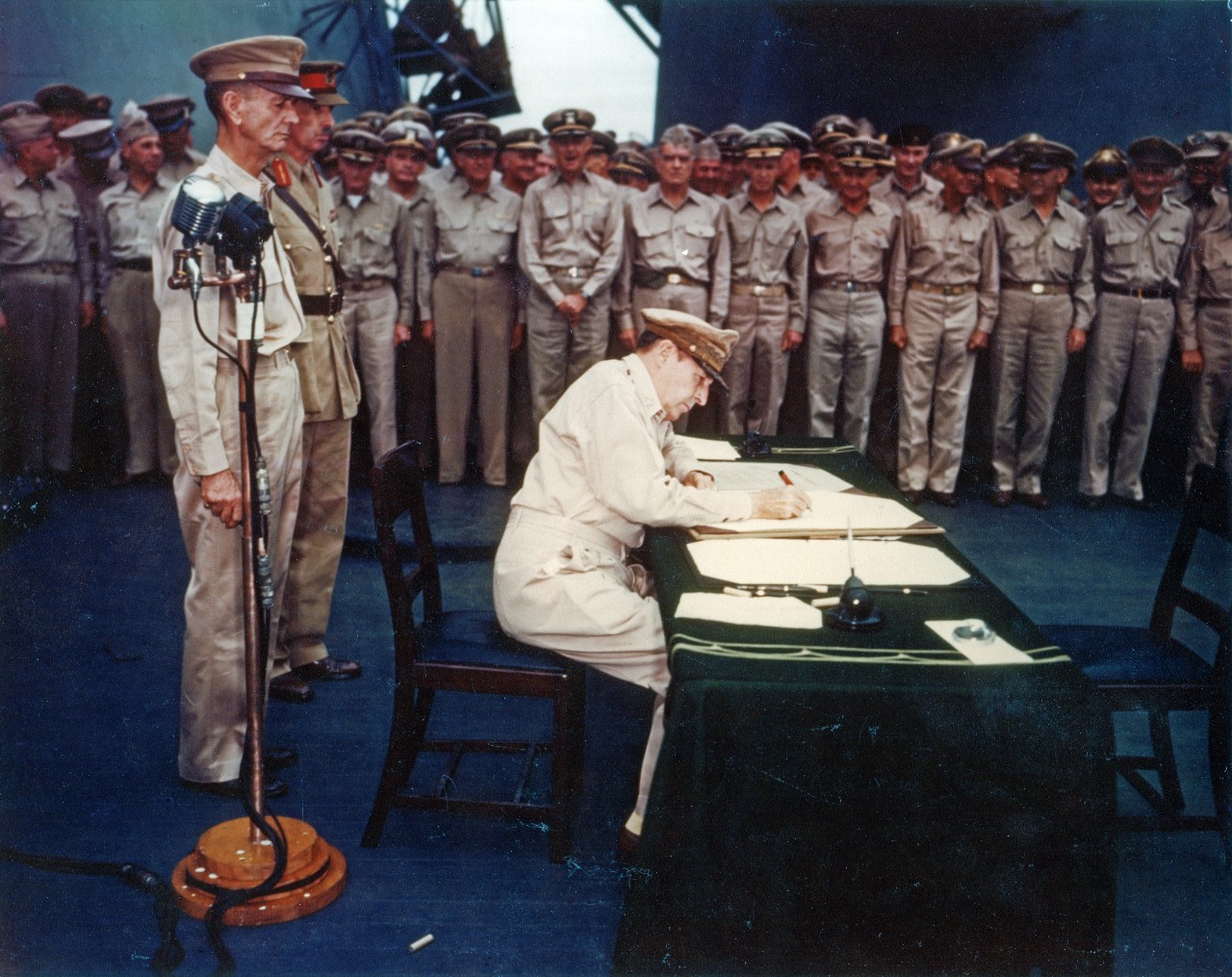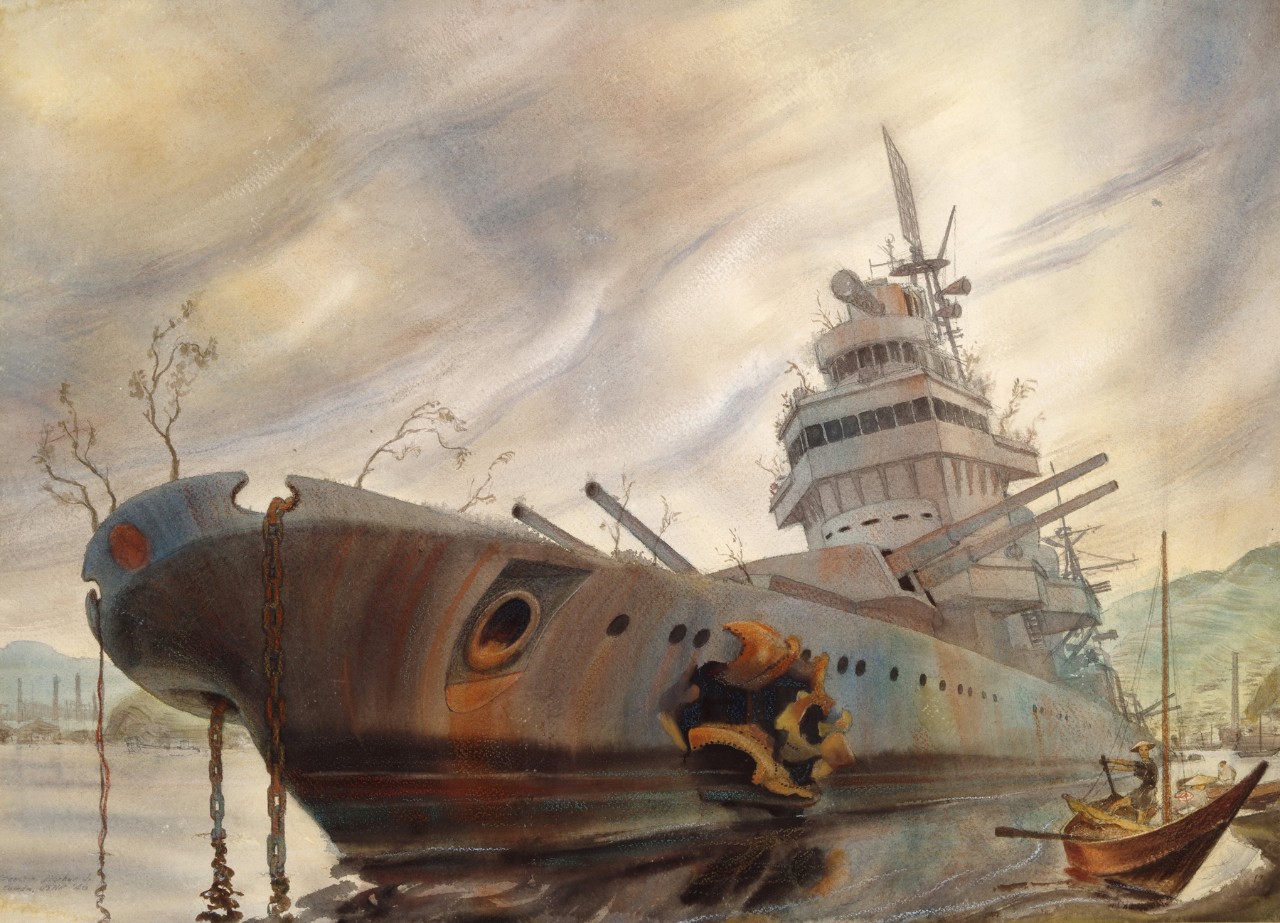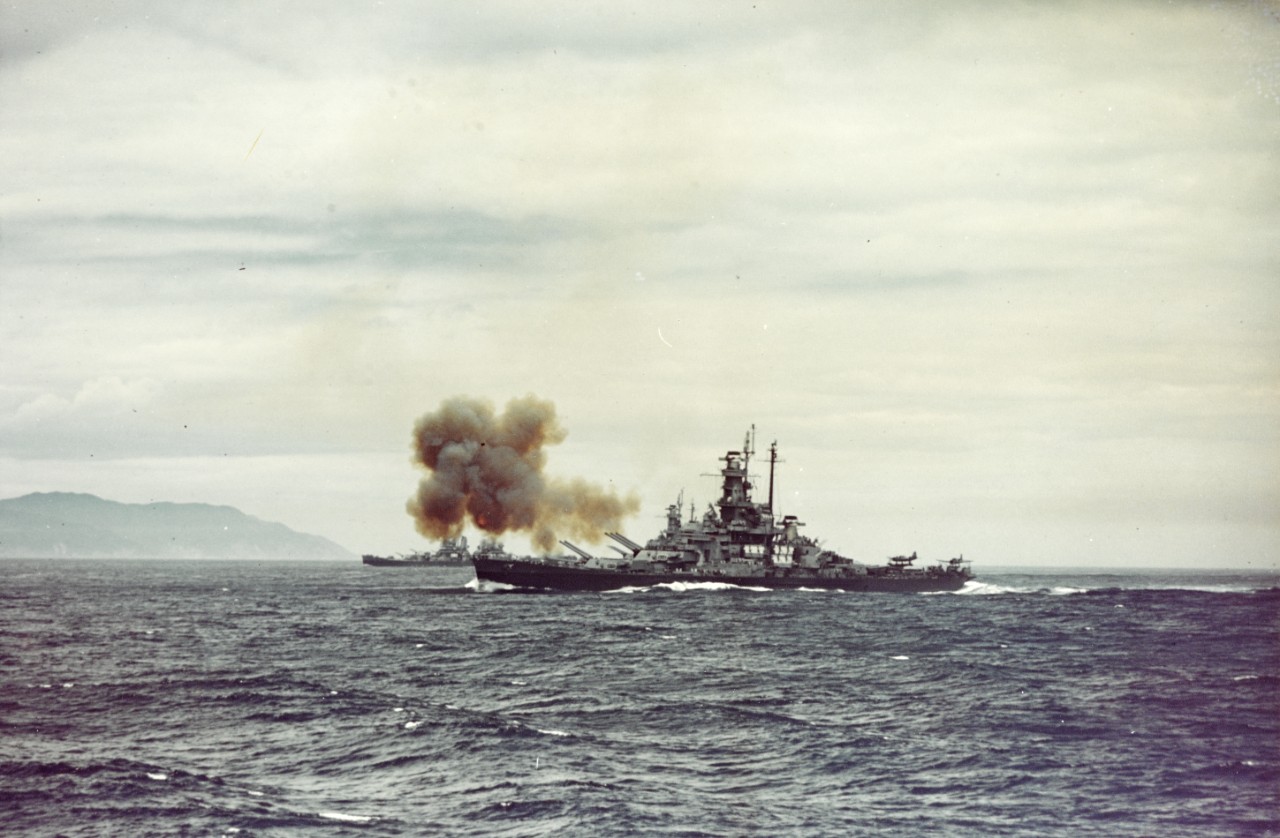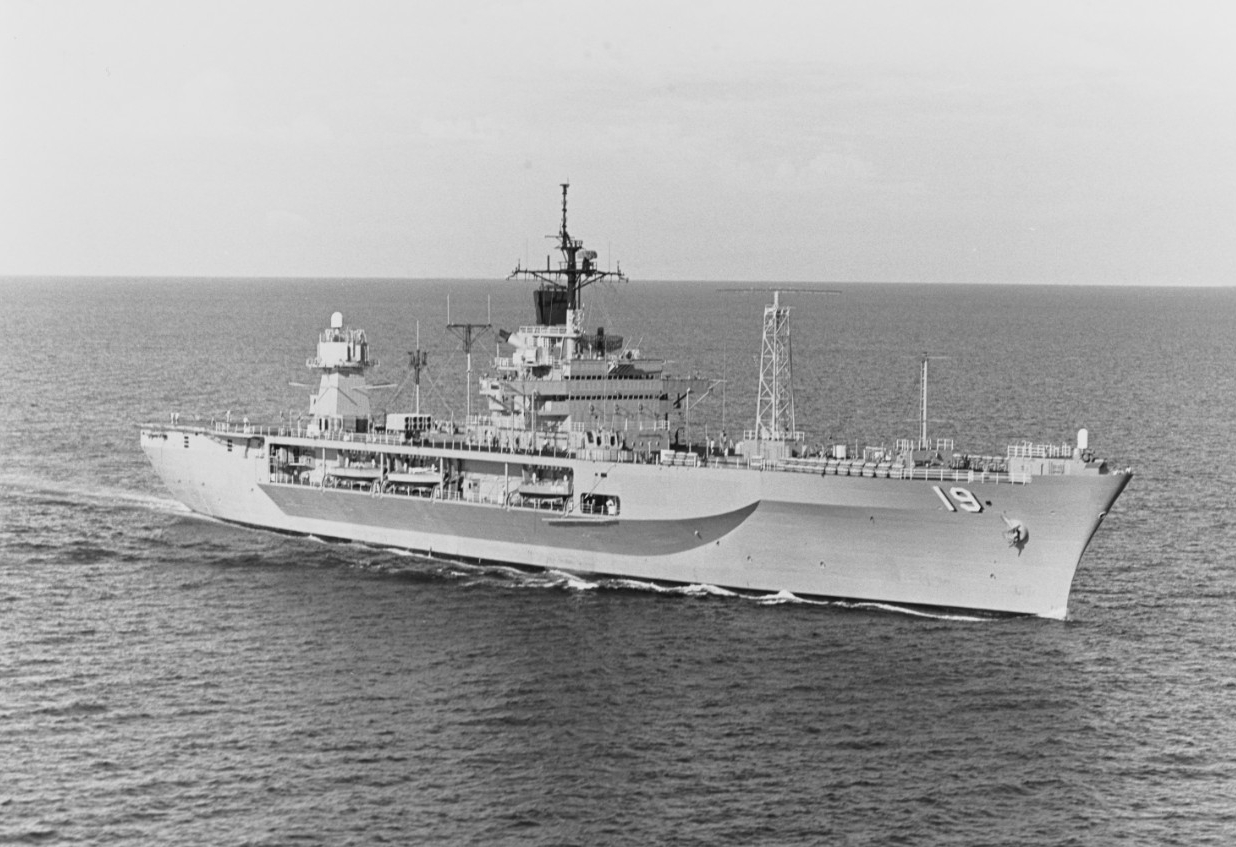H-Gram 053: The End of the Imperial Japanese Navy and the Surrender of Japan
16 September 2020
General of the Army Douglas MacArthur signs the Instrument of Surrender, as Supreme Allied Commander, on board USS Missouri (BB-63), 2 September 1945. Behind him are Lieutenant General Jonathan M. Wainwright, U.S. Army, and Lieutenant General Sir Arthur E. Percival, British Army, both of whom had just been released from Japanese prison camps. Officers in the front row, from Percival on, are (left to right): Vice Admiral John S. McCain, USN; Vice Admiral John H. Towers, USN; Admiral Richmond K. Turner, USN; Admiral William F. Halsey, USN; Rear Admiral Robert B. Carney, USN; Rear Admiral Forrest Sherman, USN; General Walter C. Krueger, U.S. Army; General Robert L. Eichelberger, U.S. Army; General Carl A. Spaatz, USAAF and General George C. Kenney, USAAF (USA C-4627).
This H-gram covers the final U.S. carrier strikes against the remnants of the Imperial Japanese Fleet in July 1945; the series of U.S. battleship shore bombardments of the Japanese Home Islands; the aerial mining campaign against Japan (Operation Starvation;) and the final surrender of Japan and ceremony aboard Missouri (BB-63). It also covers events of Operation Desert Shield during September 1990.
Download a pdf of H-Gram 053 (5.9 MB).
75th Anniversary of World War II: The End of the Imperial Japanese Navy and Surrender of Japan
“Welcome to Atsugi from Third Fleet,” read the banner that greeted General MacArthur’s advance team when they landed in Japan on 28 August 1945. They’d been beaten by a pilot from carrier Yorktown (CV-10), who, against all orders (and common sense), had brazenly landed at Atsugi after the cease-fire, but before the official surrender, and ordered the Japanese to put up the sign. For probably obvious reasons, the pilot’s name appears to be unknown to history.
In my previous H-grams (051 and 052), I discussed the final U.S. Navy air strikes on Japan and the Navy’s participation in the development and employment of the atomic bombs, so parts of this H-gram are out of sequence. These actions were nevertheless important to the outcome of the war.
The End of the Imperial Japanese Navy, July 1945
By July 1945, what was left of the Japanese navy was starved for fuel and critical maintenance, and was no longer capable of offensive operations. It was barely capable of any defensive operations beyond being used as floating coastal defense batteries, and U.S. Navy commanders knew it. Nevertheless, Fleet Admiral Nimitz, who had smelled the stench of death and humiliation of defeat when he first arrived at Pearl Harbor in December 1941, wanted the Imperial Japanese Navy utterly destroyed and ordered the Third Fleet commander Admiral William F. Halsey to do it. Over the objection of his Fast Carrier Task Force (TF-38) commander, Vice Admiral John “Slew” McCain, and most of the carrier air group planners, Halsey ordered massive airstrikes against the heavily defended (by anti-aircraft guns) main Japanese naval base at Kure, on the Inland Sea. As it was too shallow for torpedoes, a previous strike on Kure on 19 March 1945 by Fifth Fleet (TF-58) using only bombs had damaged, but not sunk, most of the remaining Japanese ships in the harbor, at a cost of two U.S. aircraft carriers knocked out of action, one (Franklin, CV-13) for the duration of the war.
Nevertheless, McCain carried out his orders and, in two massive air strikes on 24 and 28 July, Task Force 38’s 16 fleet carriers flew over 3,600 offensive sorties against Kure and other targets surrounding the Inland Sea. At a cost of 101 U.S. Navy aircraft and 88 men, TF-38 aircraft sank one of the two (non-operational) Japanese fleet carriers present (the second was blasted by a 2,000-pound bomb, but stubbornly remained afloat), and the one escort carrier. All three of the battleships, two heavy cruisers, and light cruiser present were sunk (despite all of them being extensively camouflaged and distributed about the harbor in hard-to-hit spots among steep hills), along with other ships sunk or badly damaged.
The destruction in the harbor was so complete that even two armored cruiser veterans of the 1905 Battle of Tsushima and one ancient pre-Dreadnaught battleship were sunk. One previously damaged, non-operational light carrier survived (her camouflage was so good she was not seen) and, somewhat miraculously, Japan’s first aircraft carrier, Hosho, also survived. Due to the very shallow water, a number of ships that were sunk on the first day were attacked again and bombed deeper into the mud on the second day of strikes. These were among the very last of 334 warships and 300,000 Japanese sailors lost in the war; only a handful of mostly-damaged Imperial Japanese Navy ships remained afloat.
Battleship Shore Bombardments, July/August 1945
Throughout the month of July and into August 1945, the carriers of Admiral Halsey’s Third Fleet ranged up and down the east coast of the Japanese home islands, attacking targets essentially at will. One of the last such strikes, on 9–10 August, disrupted Operation Tsurugi, a Japanese navy plan for 60 Betty bombers with 600 navy and army commandos on board to fly a one-way mission against the U.S. B-29 bases in the Marianas.
With virtually no Japanese opposition (the Japanese were holding back about 12,000 mostly well-hidden aircraft to oppose the anticipated invasion), an emboldened Halsey ordered a series of audacious bombardments of key Japanese industrial installations ashore by Third Fleet battleships and other surface combatants, sometimes at night, sometimes in broad daylight. In the first such bombardment, on 15 July, three battleships and two heavy cruisers shelled a major iron and steel production facility at Kamaishi on northern Honshu. On the next day, three different battleships and two light cruisers blasted a major industrial facility at Muroroa, Hokkaido. In a night bombardment only 80 miles from Tokyo on 17–18 July, five U.S. battleships and one British battleship laid waste to electronics production facilities at Hitachi. The last bombardment hit Kamaishi again on 9 August, with the heavy cruiser Saint Paul (CA-73) firing the last salvo (Saint Paul also fired the last shot of the Korean War).
Operation Starvation: The Aerial Mining Campaign by B-29 Bombers: March–September 1945
Although relatively unknown today, because neither the U.S. Navy nor U.S. Air Force had much interest in making a big deal of it, the aerial mining campaign by U.S. Army Air Forces B-29 Superfortress bombers (Operation Starvation) sank more Japanese ships (over 500) in the last six months of the war than all other causes combined, including U.S. submarines. Worse (from an Air Force perspective) the post-war Strategic Bombing Survey determined that the 5 percent of B-29 sorties that the Air Force reluctantly committed to the mining campaign actually caused more disruption to Japanese industrial war production than did the direct “precision” daylight raids on Japanese factories by choking off the flow of raw materials that the factories needed. Had the war not ended when it did, the mining campaign would soon have resulted in mass starvation in Japan, an alternative to the atomic bombs (but not necessarily more humane) toward ending the war.
Pushed by Admiral Nimitz over the Army Air Forces’ institutional lack of interest, the proposed mining campaign was finally enthusiastically endorsed by the new commander of the XXI Bomber Command, Major General Curtis LeMay, who sought and received a much greater commitment to the mission than the Air Forces had initially agreed. Between 27 March and the end of the war, the 160 B-29s of the 313th Bomb Wing laid 12,135 sophisticated bottom influence mines in 26 different fields during 46 missions. During 1,529 sorties, 15 B-29s and 103 airmen were lost, but over 670 Japanese ships were sunk or severely damaged. In terms of cost of the platforms and cost in lives, the strategic aerial mining campaign was the most cost-effective ship-killing operation of the war.
For more on the Kure strikes, shore bombardments and Operation Starvation, please see attachment H-053-1.
The Japanese Decision to Surrender, August 1945
Both the Japanese army and navy had independent atomic weapons programs, and their leaders understood full well the extreme difficulty in trying to develop an atomic bomb. The reaction of Admiral Toyoda, chief of the Navy General Staff, when informed of the Hiroshima explosion, could be summed up as, “If it really was an atomic bomb, the United States can’t have very many of them, and most Japanese cities have already been laid waste by B-29 firebombing raids, anyway.” Toyoda was one of six members of the key decision-making body for the government of Japan, the Supreme Council for the Direction of the War, which consistently remained deadlocked between hardliners who wanted to “fight until extinction” and those who wanted to negotiate a response (that protected the emperor’s position) to the Allies’ Potsdam Declaration. This called on Japan to accept either “unconditional surrender” or “prompt and utter destruction.” It took the profound combined shock events of the Soviet entry into the war and the second atomic bomb on Nagasaki (both on 9 August), a highly effective leaflet-dropping operation, and ultimately the emperor’s personal decision at accept the Allied terms to bring about the first surrender of Japan to a foreign power in history. Even then, the emperor’s decision was nearly thwarted by a coup attempt that came dangerously close to succeeding.
The Japanese Surrender: August/September 1945
Fleet Admiral Nimitz’ directive of 15 August stated, “With the termination of hostilities against Japan, it is incumbent on all officers to conduct themselves with dignity and decorum in the treatment of the Japanese…. The use of insulting epithets in connection with the Japanese as a race or as individuals does not now become the officers of the United States Navy.” With that, Nimitz set in motion a process of magnanimity in victory that would, in astonishingly short order, transform Japan from a bitter foe into a great friend and ally of the United States.
Indeed, although the mighty array of over 250 warships in Tokyo Bay and the low-altitude fly-over by 450 Navy carrier aircraft and hundreds of B-29s was meant to leave no doubt in Japanese minds as to who the victor was, the entire surrender proceedings aboard the battleship Missouri were conducted with the dignity and decorum that Nimitz expected, and which astonished the defeated Japanese, who expected to be treated as they had treated those they had conquered.
Appointed by President Truman as the Supreme Commander Allied Powers (SCAP) in Japan, General of the Army Douglas McArthur stated in his opening remarks, “It is my earnest hope, and indeed the hope of all mankind, that from this solemn occasion a better world shall emerge out of the blood and carnage of the past—a world founded on faith and understanding, a world dedicated to the dignity of man and the fulfillment of his most cherished wish for freedom, tolerance, and justice.” The terrible war ended, and the world was changed.
During World War II, 36,950 U.S. Navy personnel were lost due to enemy action.
For more on the surrender of Japan, please see attachment H-053-2.
USS Indiana (BB-58) fires a salvo from her forward 16-inch/45-caliber guns at the Kamaishi plant of the Japan Iron Company, 250 miles north of Tokyo. A second before, USS South Dakota (BB-57), from which this photograph was taken, fired the initial salvo of the first naval gunfire bombardment of the Japanese Home Islands. The superstructure of USS Massachusetts (BB-59) is visible directly behind Indiana. The heavy cruiser in the left center distance is either USS Quincy (CA-71) or USS Chicago (CA-136) (80-G-K-6035).
30th Anniversary of Operation Desert Shield and Desert Storm, September 1990
The guided missile frigate Reid (FFG-30) fired the first shot of Desert Shield/Desert Storm on 18 August 1990 and, later the same day, it was followed by USS Robert G. Bradley (FFG-49). In separate incidents, both ships fired across the bows of Iraqi tankers leaving the Arabian Gulf, the first attempted enforcement actions of United Nations Security Council Resolution 661 (passed 16 August), which declared an embargo on Iraqi oil (and stolen Kuwaiti oil) from leaving Iraq and prohibited goods from entering. The tankers called our bluff and kept going as the actual use of force to enforce the embargo was not authorized by the UNSC until 26 August. Nevertheless, also on 18 August, England (CG-22) and Scott (DDG-995) diverted ships in the Red Sea and North Arabian Gulf, the first diversions of Operation Desert Shield. By the beginning of September, U.S. Navy enforcement of the UN sanctions was well underway, averaging 40 intercepts and four boardings per day—1,000 intercepts by 16 September.
On 19 August, the Commander of the U.S. Seventh Fleet, Vice Admiral Henry H. Mauz, was designated as the Commander, U.S. Naval Forces Central Command (COMUSNAVCENT) after flying in to Bahrain. By the time the SEVENTHFLT/NAVCENT flagship, Blue Ridge (LCC-19), arrived in Bahrain on 1 September, three U.S. aircraft carriers and a battleship were already on station in the Central Command area of operations (AOR), ready to counter any further Iraqi aggression. Following the Iraqi invasion of Kuwait on 2 August, the carrier Dwight D. Eisenhower (CVN-69) transited the Suez on 7 August, the same day that Independence (CV-62) arrived in the Gulf of Oman (U.S. Air Force F-16s first arrived in Saudi Arabia on 10 August). Battleship Wisconsin (BB-64) transited the Suez on 17 August and entered into the Arabian Gulf on 24 August. Saratoga (CV-60) came through the Suez on 22 August. A fourth carrier, John F. Kennedy (CV-67), arrived in the Red Sea on 14 September.
The first fast sealift ships arrived on 27 August. As there were no established U.S. bases in Saudi Arabia, without sealift the Air Force and Army would have run out of bombs and ammunition in short order had the war commenced at that point. The hospital ship Comfort (T-AH-20) arrived 7 September and Mercy (T-AH-19) by 23 September. Between 4 and 11 September, 20 Atlantic and Pacific Fleet amphibious ships arrived in the CENTCOM AOR and, by 16 September, all were in the Gulf of Oman, carrying the 4th Marine Expeditionary Brigade (MEB), the 13th Marine Expeditionary Unit (MEU), and 1st Battalion, 6th Marine Regiment.
On 31 August, Biddle (CG-34) conducted the first boarding under UNSCR 661; the empty ship was allowed to proceed into Aqaba, Jordan. On 4 September, Goldsborough (DDG-20) intercepted and boarded the Iraqi cargo ship Zanoobia, which was found to be carrying prohibited cargo and was diverted, the first diversion of an Iraqi-flag ship. On 27 September, Elmer Montgomery (FF-1082) had to fire warning shots to get the Iraqi tanker Tadmur to stop for boarding.
For more on the initiation of Operation Desert Shield, please see attachment H-052-3.
As always, you are welcome to forward H-grams to spread these stories of U.S. Navy valor and sacrifice. Prior issues of H-grams, enhanced with photos, can be found here … plus lots of other cool stuff on Naval History and Heritage Command’s website. I had hoped to get this H-gram done before the 2 September anniversary of the surrender of Japan, but, oh well …






